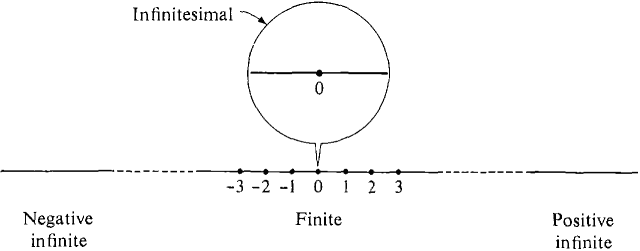| The ebook Elementary Calculus is based on material originally written by H.J. Keisler. For more information please read the copyright pages. |

|

Home  Real and Hyperreal Numbers Real and Hyperreal Numbers  Infinitesimal, Finite and Infinite Numbers Infinitesimal, Finite and Infinite Numbers  Application of the Principles Application of the Principles |
|






|
|
Application of the Principles
An important use of the Transfer Principle is to carry out computations with infinitesimals. For example, a computation with infinitesimals was used in the slope calculation in Section 1.4. The Extension Principle tells us that there is at least one positive infinitesimal hyperreal number, say ε. Starting from ε, we can use the Transfer Principle to construct infinitely many other positive infinitesimals. For example, ε2 is a positive infinitesimal that is smaller than ε, 0 < ε2 < ε. (This follows from the Transfer Principle because 0 < x2 < x for all real x between 0 and 1.) Here are several positive infinitesimals, listed in increasing order: ε3, ε2, ε/100, ε, 75ε, √ε, ε + √ε. We can also construct negative infinitesimals, such as -ε and -ε2, and other hyper-real numbers such as 1 + √ε, (10 - ε)2, and 1/ε. We shall now give a list of rules for deciding whether a given hyperreal number is infinitesimal, finite, or infinite. All these rules follow from the Transfer Principle alone. First, look at Figure 1.5.1, illustrating the hyperreal line.
Figure 1.5.1
|
|
Home  Real and Hyperreal Numbers Real and Hyperreal Numbers  Infinitesimal, Finite and Infinite Numbers Infinitesimal, Finite and Infinite Numbers  Application of the Principles Application of the Principles |
|
Last Update: 2006-11-15


